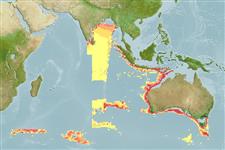Elasmobranchii (haaien en roggen) (sharks and rays) >
Squaliformes (Sleeper and dogfish sharks) >
Squalidae (Dogfish sharks)
Etymology: Squalus: Genus name from Latin 'squalus' meaning shark (Ref. 6885, 27436); nasutus: Name from Latin 'nasutus' meaning large-nosed, referring to its elongated prenarial snout..
More on authors: Last, Marshall & White.
Environment: milieu / climate zone / depth range / distribution range
Ecologie
marien; diepte 300 - 850 m (Ref. 58443), usually 300 - 400 m (Ref. 58443). Tropical
Eastern Indian Ocean: Western Australia. Probably extending to Westerm Pacific, the Philippines and Indonesia.
Lengte bij maturiteit / Grootte / Gewicht / Leeftijd
Maturity: Lm ?, range 46 - ? cm
Max length : 49.9 cm TL mannelijk / geslacht onbekend; (Ref. 58443); 59.0 cm TL (female)
Korte beschrijving
Morfologie | Morfometrie
This small species of the ‘japonicus group’ has the following set of characters: very elongate body, depth 9.4-11.4% TL; narrow and long snout, preoral length 1.85-2.01 times its horizontal prenarial length, 11.1-11.7% TL; large eyes, 4.3-5.1% TL; secondary lobe of anterior nasal flap is well developed; small, raked dorsal fins; first dorsal-fin spine short, weak; second dorsal-fin spine short with strong base; pectoral fin of adult not falcate; pectoral-fin inner margin is short, 6.6-7.1% TL; caudal bar almost upright, short, broad, extending from the caudal fork to the posterior margin of the upper lobe for 0.4-0.5 of its length, upper caudal blotch is somewhat linear, and is located near the dorsal margin of fin lobe; flank denticles weakly tricuspidate; monospondylous centra 36-39, precaudal centra 78-81, total centra 103-109 (Ref. 58443).
Occurs on or near the bottom of the upper continental slope at 298-850 m; viviparous with yolk-sac dependency; no reproductive and diet data are available, however, it is presumed that the species feeds on small fishes, cephalopods, and crustaceans (Ref. 58048). Trawled mainly in 300-400 m (Ref. 58443). Marketed for its meat, fins, and liver oil which is of high value (Ref. 58048).
Levenscyclus en paargedrag
Maturiteit | Voortplanting | Paaien | Eieren | Fecunditeit | Larven
Distinct pairing with embrace (Ref. 205).
Last, P.R., L.J. Marshall and W.T. White, 2007. Squalus nasutus sp. Nov., a new long-snout spurdog of the 'japonicus-group' from the Inidan Ocean. pp. 83-90. In P.R. Last, W.T. White and J.J. Pogonoski Descriptions of new dogfishes of the genus Squalus (Squaloidea:Squalidae). CSIRO Marine and Atmospheric Research Paper No. 014. 130 pp. (Ref. 58443)
Status op de Rode Lijst van het IUCN (Ref. 130435)
Gevaar voor de mens
Harmless
Gebruik door de mens
Meer informatie
Leeftijd/GrootteGroeiLengte-gewichtLengte-lengteLengtefrequentiesMorfometrieMorfologieLarvenLarvale populatiedynamiekRekruteringAbundantieBRUVS
ReferentiesAquacultuurAquacultuurprofielKweeklijnenGeneticaElectrophoresesErfelijkheidZiektesVerwerkingNutrientsMassaconversie
Tools
Speciale rapporten
Download XML
Internetbronnen
Estimates based on models
Preferred temperature (Ref.
123201): 8.9 - 13.1, mean 10.8 °C (based on 56 cells).
Fylogenetische diversiteitsindex (Ref.
82804): PD
50 = 0.5000 [Uniqueness, from 0.5 = low to 2.0 = high].
Bayesian length-weight: a=0.00339 (0.00162 - 0.00707), b=3.10 (2.93 - 3.27), in cm total length, based on LWR estimates for this Genus-body shape (Ref.
93245).
Trofisch niveau (Ref.
69278): 4.2 ±0.3 se; based on size and trophs of closest relatives
Weerstandsvermogen (Ref.
120179): laag, minimale populatieverdubbelingstijd 4,5-14 jaar (Preliminary K or Fecundity.).
Fishing Vulnerability (Ref.
59153): Moderate vulnerability (44 of 100).
